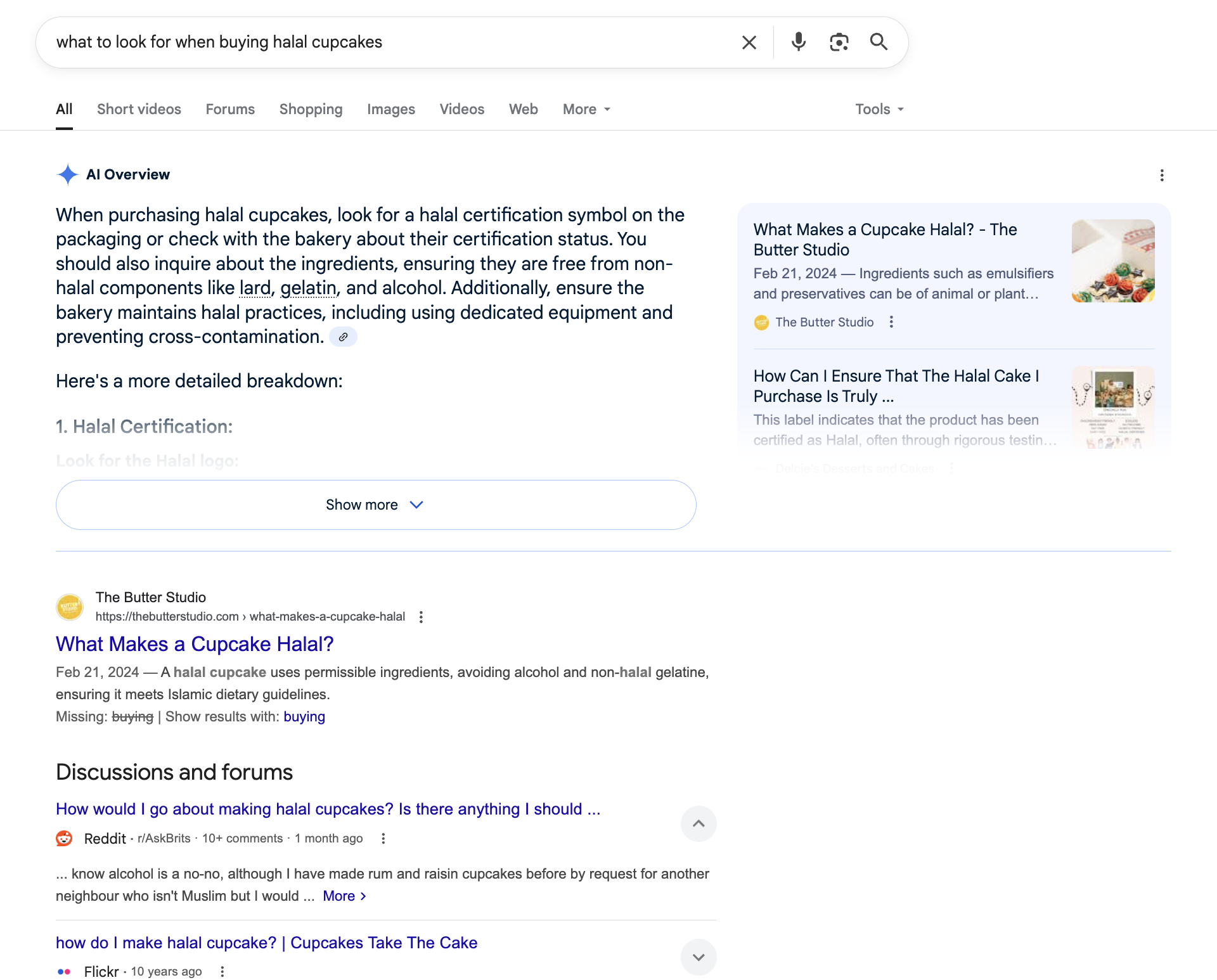
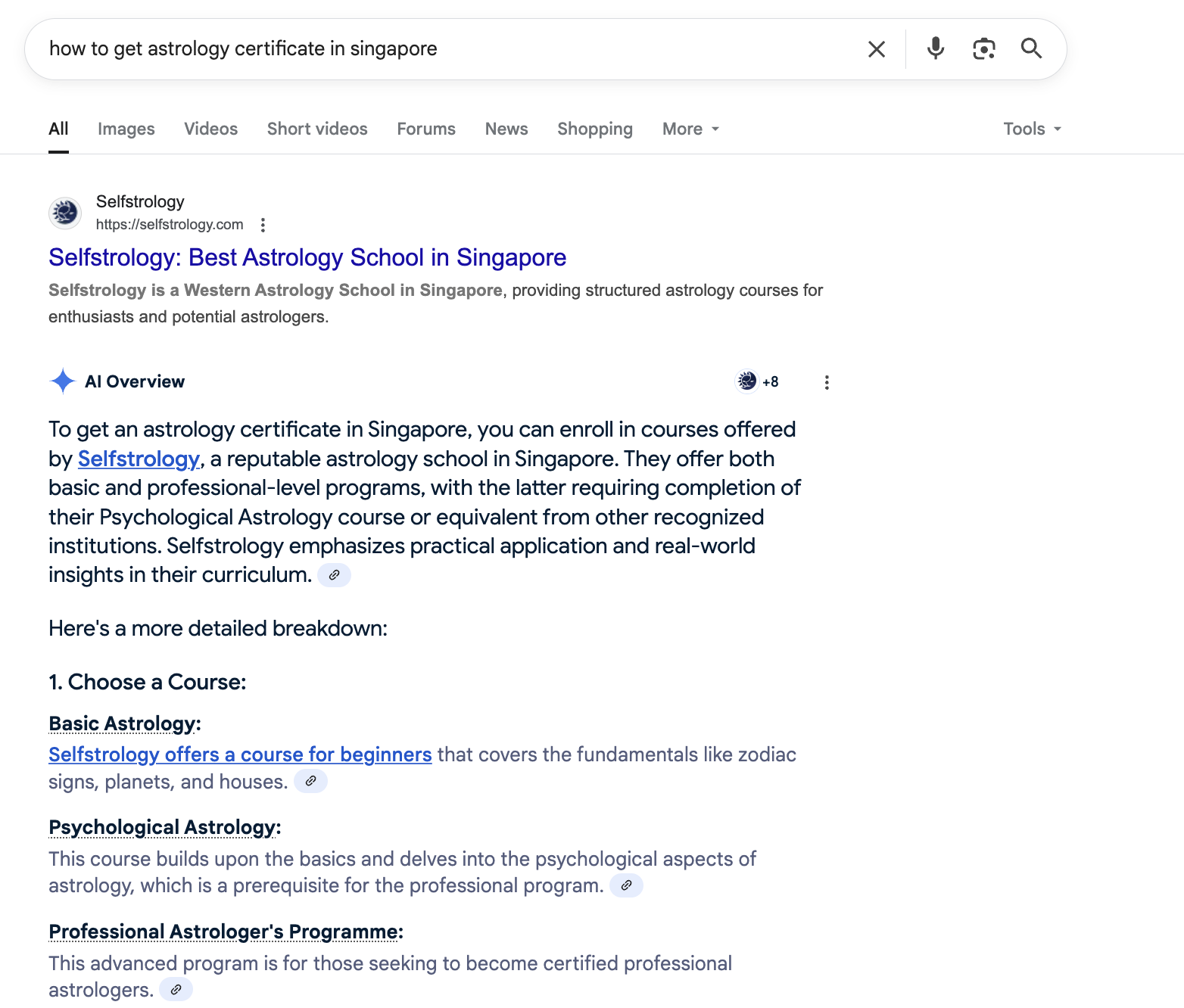
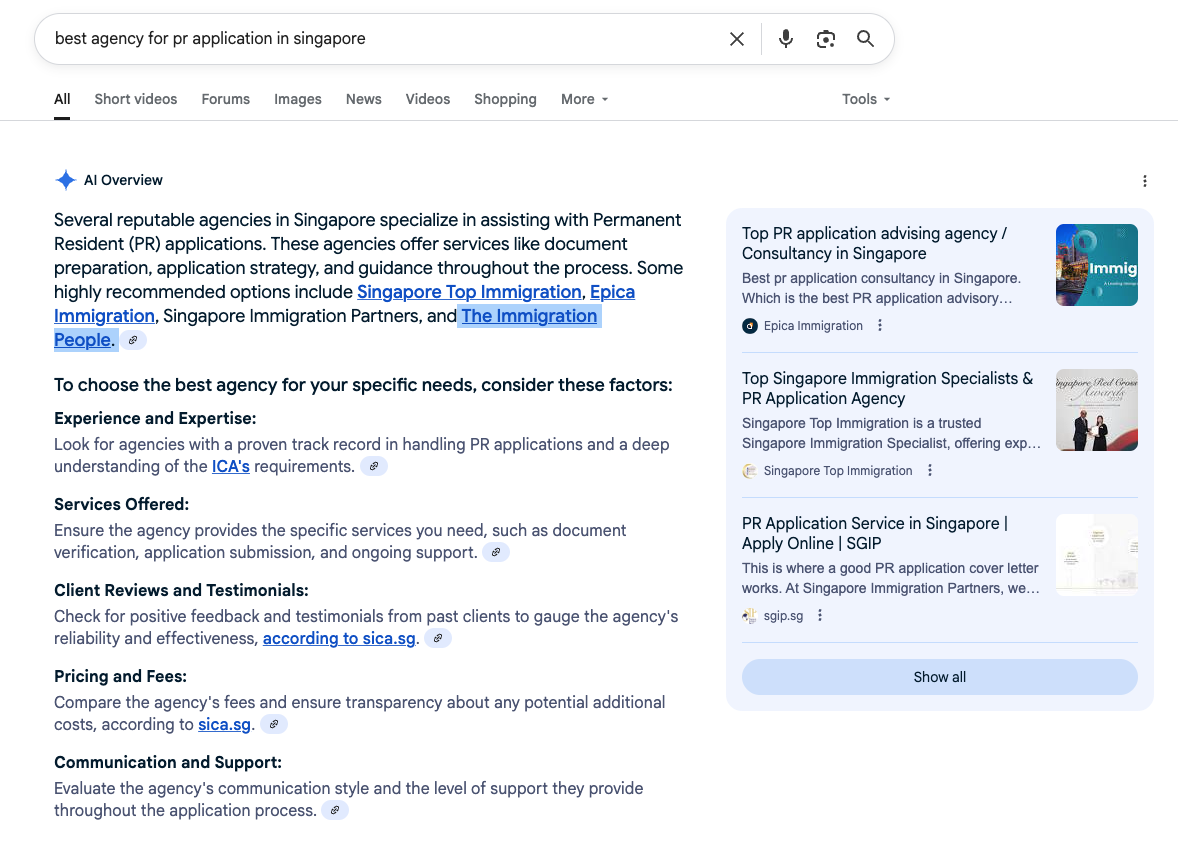
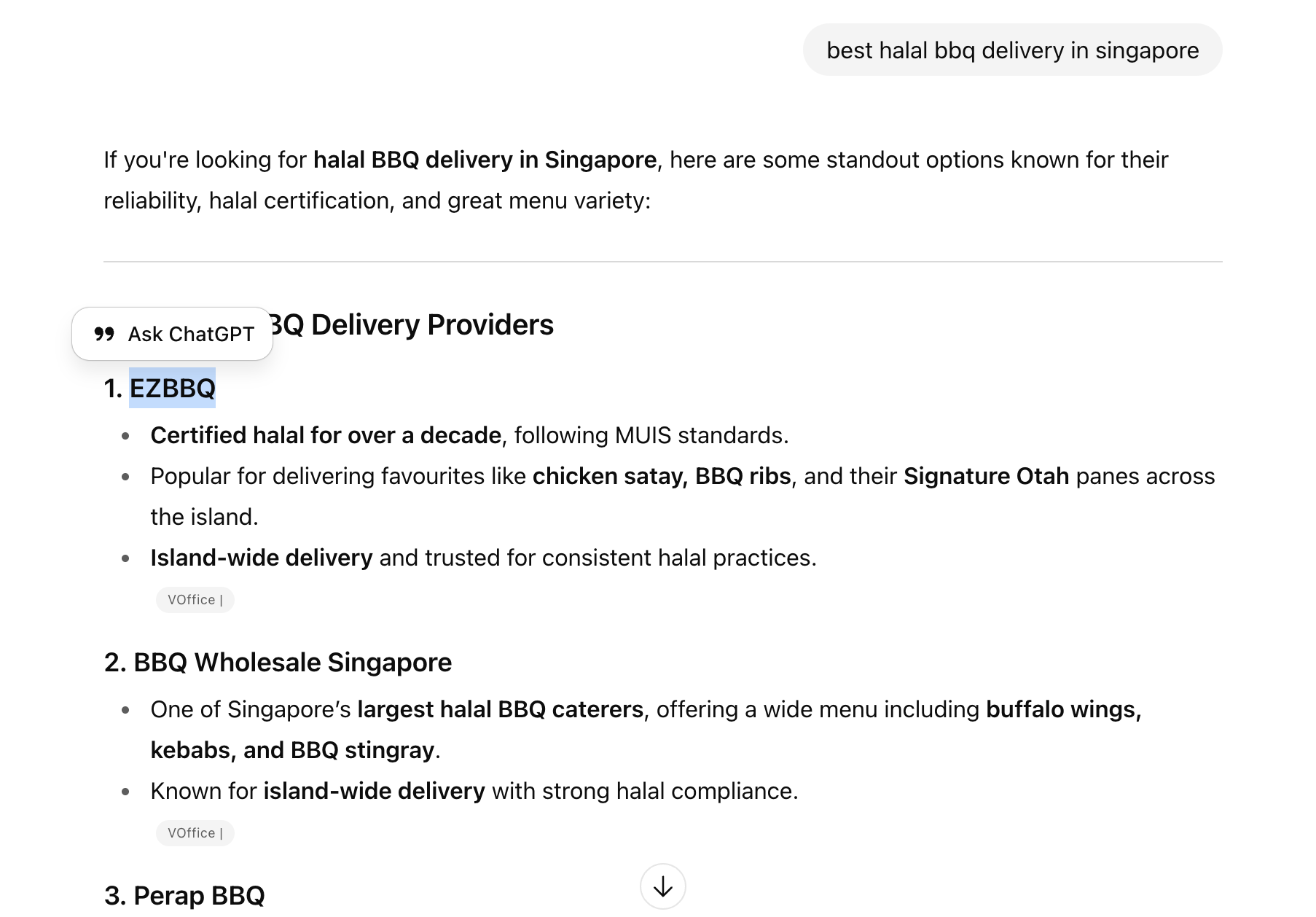
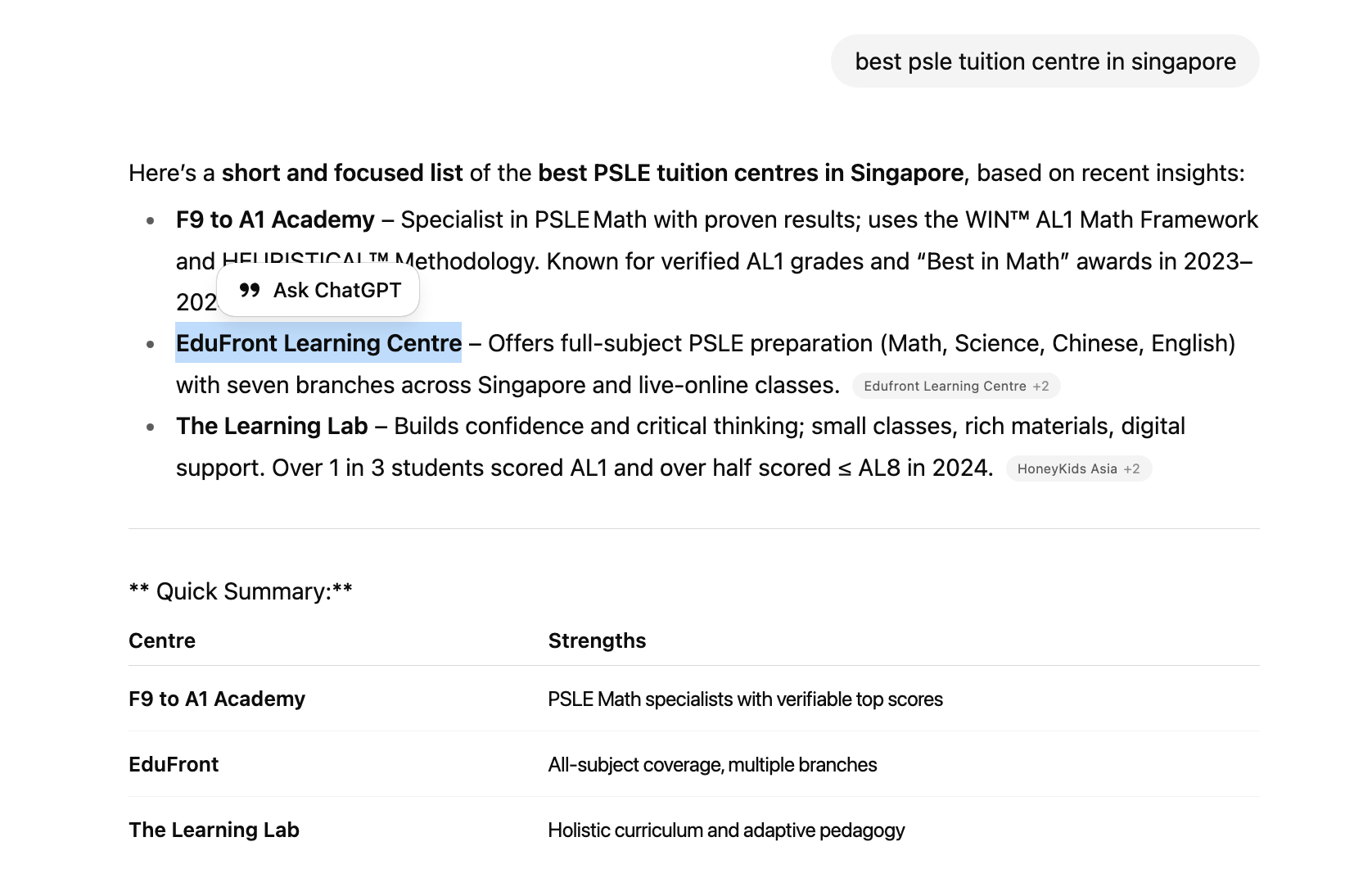
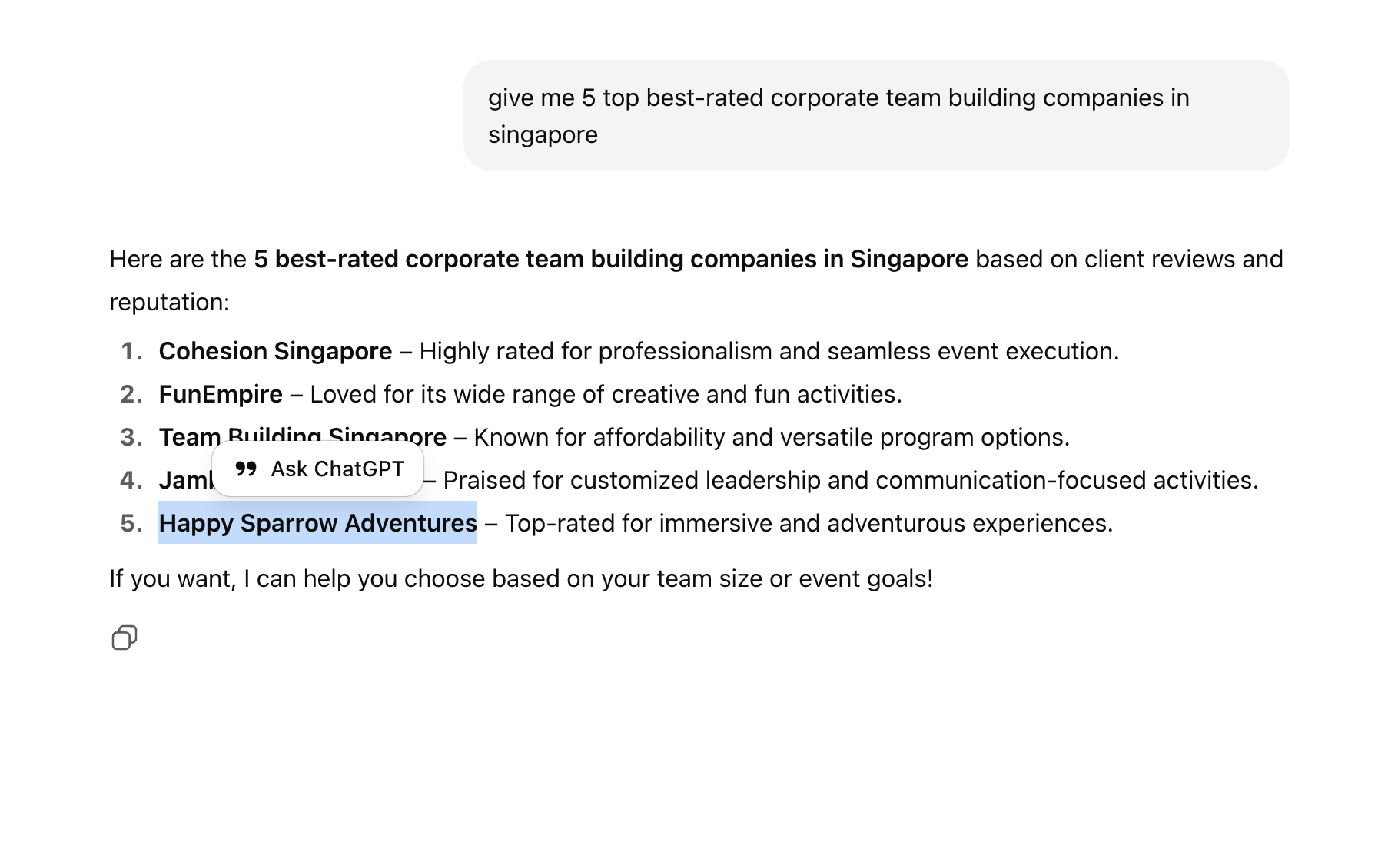
We begin with a comprehensive SEO and AI audit. This includes a technical review of your website (site speed, crawlability, structured data, indexation), on-page analysis (content depth, keyword optimisation, internal linking), and off-site authority signals (backlinks, brand mentions, EEAT).
Unlike a standard SEO audit, we also evaluate your site’s AI visibility potential by checking how well your content aligns with query patterns in AI Overviews (AIO) and Generative Engines (GEO/AEO). By identifying both strengths and gaps, we set the baseline for all improvements.
Keywords remain the backbone of SEO, but for AI-Integrated SEO we go further. We identify high-intent keywords that drive traffic in Google’s SERPs, while also mapping how these terms intersect with AI-powered answers.
For example, ranking for “PR application Singapore” in Google is one thing, but being recognised in ChatGPT or Gemini answers requires supporting content clusters that prove your authority. This stage ensures we don’t just chase search volume, but also build the right keyword foundation to appear in both organic search and AI snippets.
AI search is powered by questions, not just keywords. In this step, we analyse the exact queries people ask on platforms like ChatGPT, Gemini, Perplexity, and Google AI Overviews.
Instead of only targeting “halal catering Singapore,” we also uncover variations like “What are the best halal catering options near me?” or “Which halal caterer in Singapore delivers for events?”, the way real users phrase questions to AI tools.
By capturing these conversational search patterns, we position your website as the most relevant and authoritative source to be pulled into AI answers and Zero-Click results.
Finally, we bring everything together into a clear and actionable plan.
Goals: Define measurable outcomes, such as ranking in AI Overviews, increasing AI mentions, or driving organic traffic growth.
Strategy: Map the SEO + AI roadmap, covering technical foundations, content transformation, and authority building.
Target: Identify the priority keywords, queries, and market segments (local, regional, global) where you must dominate.
Gaps: Highlight where competitors are ahead, what’s missing in your current content, and which technical or authority signals need strengthening.
This formulation stage gives you a blueprint for AI-Integrated SEO success, ensuring every move is strategic, data-driven, and aligned with how people search today.
EEAT (Experience, Expertise, Authority, and Trust) is the core principle behind how Google and AI-driven search engines decide which content to showcase in AI Overviews, featured snippets, and zero-click results. Without strong EEAT signals, even well-optimized pages risk being ignored by AI models that prioritize credibility and safety.
Experience: Prove that your business or service works in the real world. Showcase case studies, client testimonials, and behind-the-scenes processes. Reviews on third-party sites, influencer mentions, and forums discussing your product all act as strong “real use” signals that AI systems recognize.
Expertise: Demonstrate that you are not just a provider but a specialist. Build comprehensive service pages that leave no gaps, publish original research or statistics, and highlight your team’s credentials or certifications. Topic clusters (like building a mini Wikipedia around your niche) make your site the “source of truth” that AI bots prefer to cite.
Authority: Show that others on the web trust you. Backlinks from reputable websites (especially .gov, .edu, or established media) signal legitimacy. Guest posts, citations in industry outlets, and “As Featured In” validations all reinforce that you’re a credible voice in your space.
Trust: This is the most important factor. Your website must look and feel legitimate with secure (HTTPS), fast, mobile-friendly, and free of spammy popups. Display a proper business address, phone number, and transparent policies (privacy, terms, refunds). Strong reviews across Google and other platforms validate you’re safe to do business with. If trust is missing, AI models will deprioritize your site, no matter how strong your SEO.
Basic schema markup is no longer enough. To win in the AI era, we implement rich, detailed structured data on every key page, helping Google and AI bots instantly identify what your page is about and why it’s trustworthy.
Structured data alone won’t push you to rank #1 in SEO. But it is the reason your site gets featured in:
Google Featured Snippets
AI Citations in Overviews
References in Generative Engines (ChatGPT, Gemini, Claude)
By layering advanced schema markup across your site, we give your content the best chance to be chosen as the source AI references.
We ensure your site architecture supports both SEO and AI visibility. This includes:
Building and refining pillar pages aligned with the keyword and query research done in Stage 1.
Creating clear content hierarchies so AI engines can detect topical authority.
Optimising URL structure and navigation for both users and crawlers.
A strong site structure signals to AI that your business is the definitive source on your target topics, increasing your chances of being surfaced in AI Overviews and answer engines.
We optimise every page element to align with both SEO best practices and AI readability. This includes:
Refining titles, meta descriptions, and header tags to match user intent.
Strengthening internal linking so Google and AI bots can navigate and connect topical clusters.
Improving content readability and clarity, ensuring your pages answer search queries directly.
On-page optimisation ensures your site is technically sound and content-rich, ready to be surfaced in both organic results and AI-driven answers.
Transforming content starts with a review of what already exists. Outdated, duplicate, or thin pages are either consolidated, updated, or removed. Then, new content is created with the following principles:
Answer-First Principle: Give the answer immediately in the first 50 words. For example, “There are 6 steps to apply for PR in Singapore: A, B, C...” before diving into details. This ensures AI recognizes your page as a direct response source.
Structured Formatting: Use H1–H4 headers, bullet points, and clear segmentation. Bold key terms, but not excessively. Proper formatting signals expertise and makes it easy for AI to map your content into structured snippets
AI and search engines reward depth over breadth. That’s why content should be structured into two levels of topical hierarchy:
Level 1 – Pillar Pages
Broad, central hub around a head keyword or topic (e.g., Singapore PR Guide).
Long-form (2,000+ words) and comprehensive, covering every key angle.
Serves as the main navigation point and links out to 5–20+ supporting articles.
Can be either a service page or a deep blog guide.
Level 2 – Cluster Pages
Supporting articles that cover specific subtopics in depth (e.g., PR Requirements for Students in Singapore).
Usually 1,200–1,500 words, answering one focused query with authority.
Always link back to the Pillar Page, creating a topic cluster that strengthens internal linking and signals topical depth.
Together, pillar and cluster pages form a Topic Cluster, the structural foundation that search engines use to determine topical authority. Each pillar should have at least 3+ supporting cluster articles to be considered a strong hub.
Backlinks remain one of the strongest authority signals. But quality matters more than quantity. Backlinks from high-quality sources carry far more weight than random directory listings.
Guest Posts & Features: Publish articles on reputable websites in your industry.
News & PR Mentions: Secure coverage in established media outlets. Being featured in logos and citations validates your credibility.
Authority Domains: Backlinks from .gov, .edu, or scientific journals carry disproportionate weight in building trust.
Avoid Low-Quality Links: Spammy links or irrelevant directories may hurt more than help.
Even without a direct backlink, brand mentions across the web contribute to perceived authority:
Forums & Communities: When users organically recommend or mention your brand.
Reviews & Testimonials: Appear on third-party sites where customers share experiences.
Consistent NAP Data: Ensure your Name, Address, Phone are the same across your site, business profiles, and directories.
The more your brand is discussed and referenced in credible spaces, the more AI and search engines treat you as an authority.
AI-driven search is changing how users discover information. Monitoring your presence in these new search experiences is critical:
AI Overviews Tracking: Identify whether your content appears in Google’s AI-generated summaries.
Zero-Click Search Monitoring: Check if your answers are being used directly by AI without a user click.
Answer Relevance: Analyze which types of content are more likely to be pulled by AI (structured, answer-first, authoritative).
This helps you understand not just if you’re showing up, but why you’re being chosen over competitors.
Traditional SEO metrics remain equally important, as organic traffic is still a major visibility driver:
Keyword Rankings: Track movement for both head terms (pillar pages) and long-tail queries (cluster pages).
Traffic Analytics: Monitor sessions, bounce rate, and dwell time to gauge user engagement.
Conversions: Ultimately, visibility must translate into business outcomes such as leads, sales, or sign-ups.
Competitor Benchmarking: Measure how your rankings and content footprint compare to others in your industry.
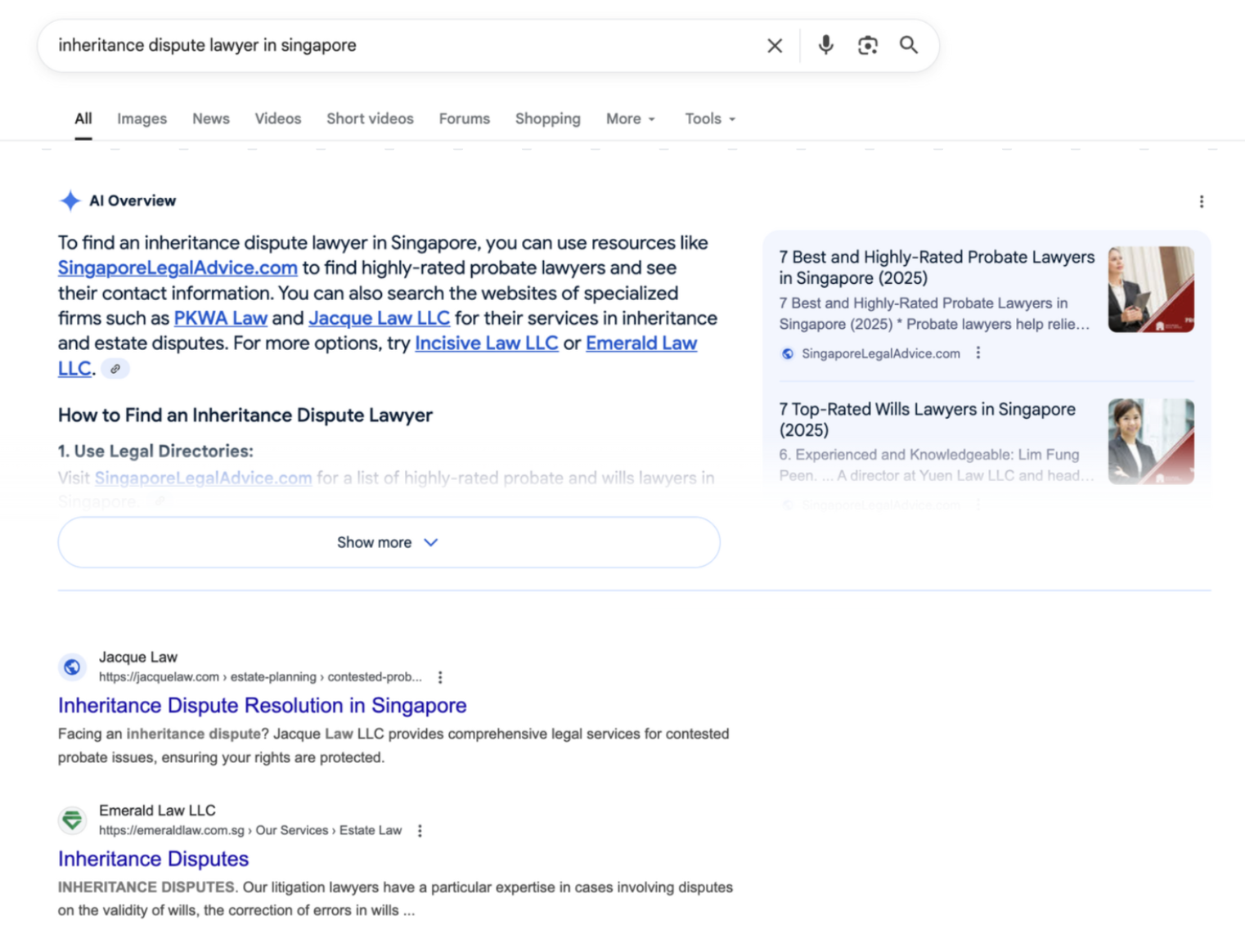
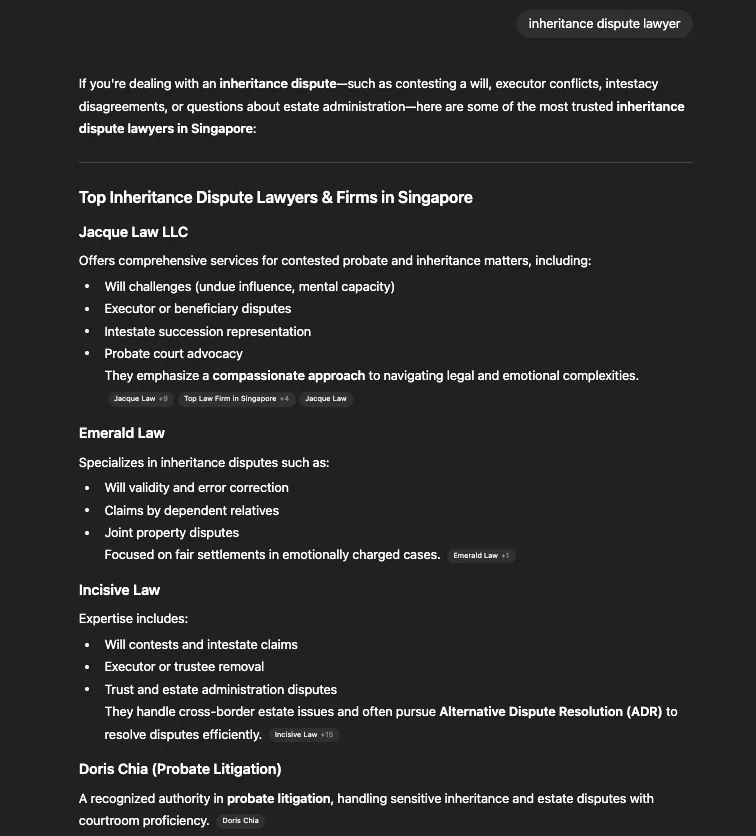
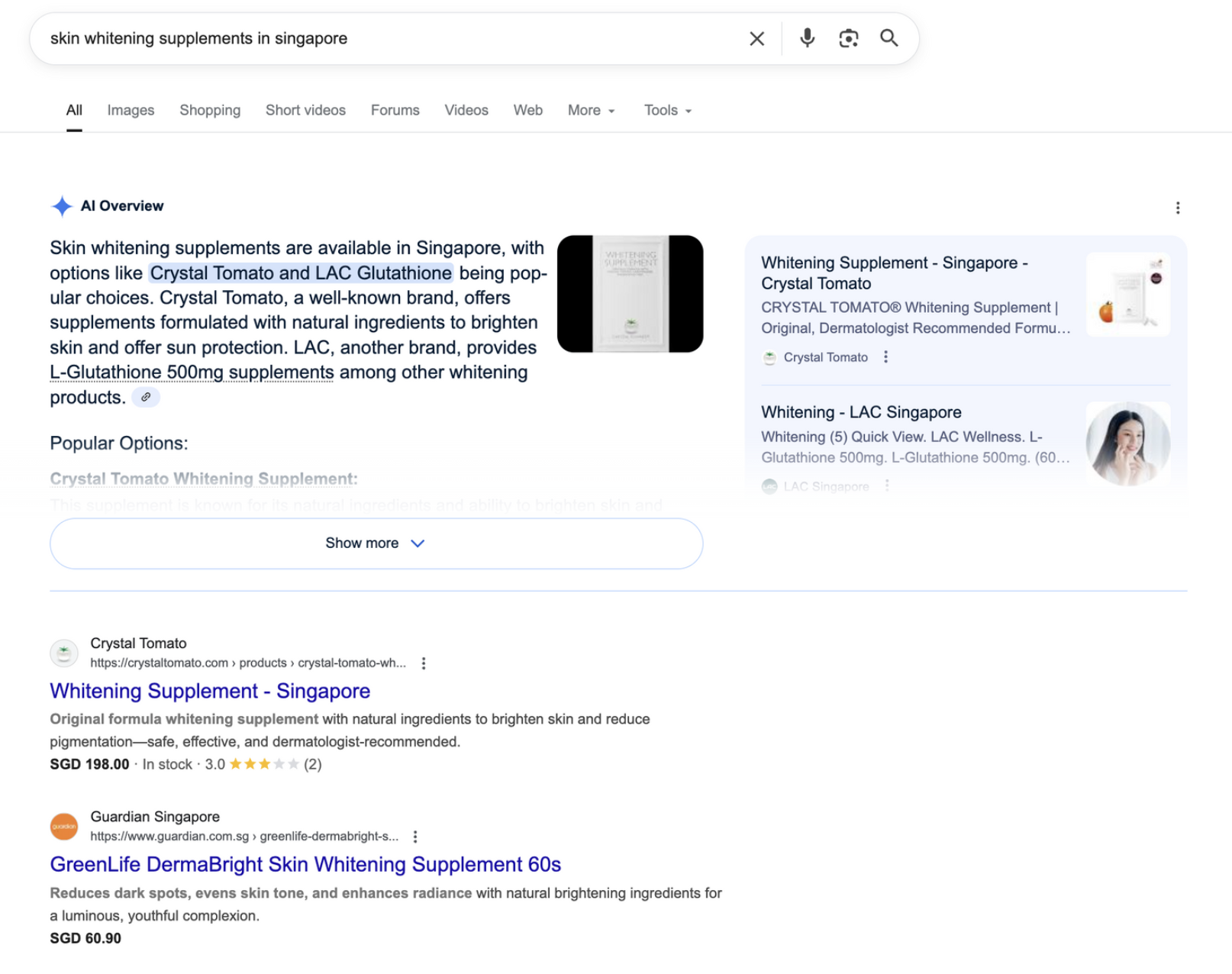
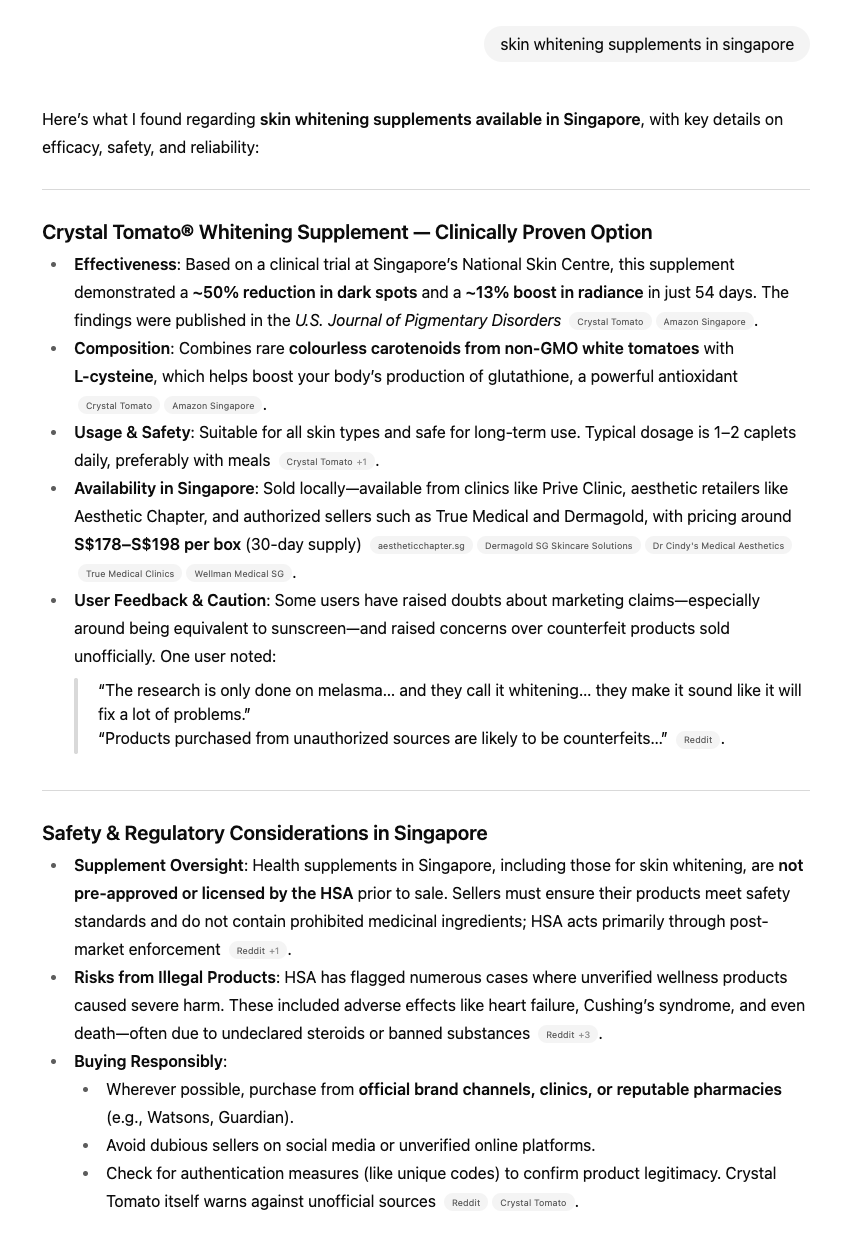

Results depend on where your website starts, but our framework follows a proven progression:
Assessment (2–4 weeks): We run a deep audit, keyword and query research, and map your goals against competitor gaps. This stage defines the strategy and targets.
Technical Foundation (1–3 months): On-page optimisation, structured data, and site structure improvements are implemented. Money pages are upgraded with EEAT signals, and content is restructured into strong pillar pages and clusters.
Authority Building (ongoing): Once the foundation is in place, we focus on building brand mentions and backlinks. This is a continuous process that steadily strengthens your site’s credibility.
Measure & Iterate (continuous): We track two dimensions—organic search performance and AI visibility (citations in AI Overviews and assistant responses)—and refine content monthly.
Most businesses see early movement during the Technical Foundation phase, with durable visibility taking hold as authority compounds. The exact pace depends on your industry competitiveness and how aggressively we implement changes.
Not necessarily. The core work overlaps heavily with strong SEO: technical optimisation, content development, and authority building. The investment difference is not in more cost, but in different priorities:
Similar costs: On-page optimisation, technical fixes, link acquisition, content creation.
AI-specific focus: Researching assistant queries, answer-first formatting, structured data, monitoring AI Overview citations, and tailoring content to satisfy EEAT signals.
For most businesses, the cost is comparable to a traditional SEO retainer, but the ROI is higher because you gain visibility in both search rankings and AI-powered results. This dual presence is where future traffic growth is heading.
Industries where people ask complex, high-stakes, or detailed questions see the strongest upside:
High consideration / YMYL: Legal, healthcare, finance, and education. These thrive because AI and Google both emphasise EEAT, and authoritative content is more likely to be cited.
Professional and B2B services: SaaS, consulting, training, and enterprise services benefit because prospects research frameworks, comparisons, and step-by-step guides that AI assistants often surface.
Local services: Clinics, home services, and hospitality see outsized impact because assistants frequently shortlist a handful of local providers—if your EEAT signals are strong, you can win visibility even against larger players.
Research-heavy e-commerce: Products requiring detailed guidance—like skincare, health supplements, or electronics—gain visibility when content is structured around user questions and authoritative product details.
These sectors align best with the staged approach: strong technical foundation, proof of expertise and trustworthiness, consistent authority building, and ongoing measurement.
Yes, and in many ways SMEs have a real advantage. AI integrated SEO rewards clarity, credibility, and structured answers, not just brand size.
For SMEs, one additional factor is critical: customer reviews. Actively increasing Google reviews not only boosts local SEO but also reinforces trust signals that AI systems consider when surfacing answers.
Address: 6001 Beach Rd, #22-01 Golden Mile Tower, Singapore 199589
Mobile: (+65) 8926 9494 | Email: [email protected]
Working Hours: Mon to Fri, 9AM to 6PM